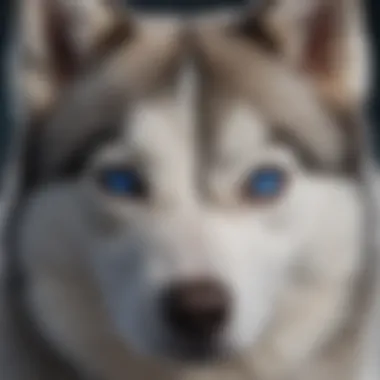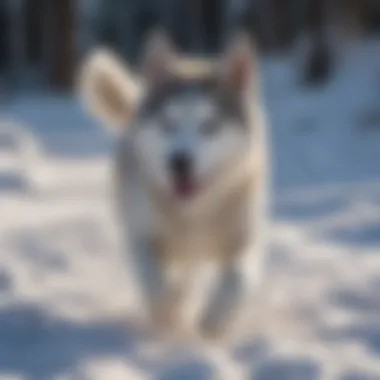Exploring Unique Traits of Female Siberian Huskies


Intro
Siberian Huskies are a distinct breed, often recognized for their striking appearances and boundless energy. Specifically, female Huskies present unique characteristics that set them apart, not only within their breed but also in relation to their human companions. Understanding these traits can help prospective and current owners provide better care and create stronger bonds.
This article will take a closer look at the specific traits and behaviors of female Siberian Huskies. We will explore their physical characteristics and behavioral patterns, aiming to give readers a comprehensive understanding of their needs and dynamics within social structures. With this knowledge, owners can enhance the experience of raising a female Husky, acknowledging the unique challenges and rewards they bring.
Fascinating Facts About the Animal
Unique Characteristics
Female Huskies typically weigh between thirty-five to fifty-five pounds. They possess a thick double coat that comes in various colors, often featuring striking markings on their faces. Their ears are erect and triangular, contributing to their wolf-like appearance.
Female Huskies are known for their intelligence and curiosity. They are quick learners but often require consistent training to harness their independent nature. This breed can display stubbornness, which poses challenges during training. Patience and positive reinforcement work best when teaching commands.
Extraordinary Abilities
Huskies were bred to pull sleds across icy terrains, showcasing their endurance and strength. Despite their robust build, female Huskies are agile and quick. They can run at speeds of up to 28 miles per hour, making them highly capable in various activities like agility training or running alongside their owners.
"The Siberian Husky is a breed designed for extreme conditions, illustrating resilience and adaptability."
Behavior and Habitat
Natural Habitats
Originally from Siberia, these dogs thrive in colder climates. They possess a thick coat that protects them from harsh weather, making them well-suited for icy environments. However, they can adapt to different settings, as long as they have enough space to exert their energy. Urban owners should ensure they have access to parks or open areas for regular exercise.
Social Structures
Female Huskies are inherently social animals. They thrive in family environments and enjoy interacting with both humans and other dogs. In a pack setting, they exhibit strong social bonds, often engaging in playful behaviors. Creating a stimulating environment is essential for these dogs, as boredom can lead to destructive habits.
Recent Scientific Discoveries
Latest Research Findings
Recent studies have shed light on the unique behavioral traits of female Huskies. Research indicates that their problem-solving skills are on par with those of other intelligent breeds. This intelligence can manifest in a desire to explore and escape confined spaces. Understanding these behaviors helps owners secure environments that allow for exploration, while still prioritizing safety.
Breakthroughs in Animal Biology
Advancements in genetics have provided insights into the health of female Huskies. Researchers have identified specific genes associated with certain health conditions prevalent in the breed. Knowing these genetic risks allows owners to take preemptive measures in veterinary care and lifestyle adjustments.
Cultural Significance
Animals in Folklore
Huskies hold a significant place in the folklore of indigenous peoples in Siberia. These dogs are often seen as symbols of companionship and resilience. Stories frequently highlight the partnership between Huskies and humans, showcasing their critical roles in survival.
Influence on Art and Literature
The allure of Siberian Huskies has penetrated various forms of art and literature. Artists and authors often depict them as symbols of beauty and loyalty. Exploring their representation across cultures provides a deeper understanding of the breed’s impact on society.
This article will explore these individual aspects in more detail as we continue to delve into the unique characteristics of female Huskies.
Preface to Siberian Huskies
Siberian Huskies hold a unique space in the canine world. Understanding their characteristics offers valuable insights for current and prospective owners. This introduction highlights key elements about Huskies, focusing on their origins, adaptability, and overall behavior. Recognizing these traits is essential for anyone considering this breed.
Historical Background
Siberian Huskies originated in the northeastern part of Asia, specifically the Chukchi people, who bred them primarily for pulling sleds over long distances. This breed played a crucial role in the transportation and survival of nomadic tribes. Their endurance and strength were pivotal, especially in extreme weather conditions.


Over time, Huskies became well-known during various expeditions in the Arctic regions. Their talents were recognized during the Alaskan gold rush in the 1890s, prompting many explorers to depend on these dogs for their journeys. Such historical significance illustrates not only their physical capabilities but also their deep-rooted connection to human endeavors.
The breed's history helps potential owners understand their instincts and behavioral patterns. Knowing their past enriches ownership experiences, making training, socialization, and care more straightforward and effective.
Physical Features
Siberian Huskies exhibit distinct physical traits that set them apart from other breeds. Typically, they weigh between 35 to 60 pounds and stand about 20 to 24 inches tall at the shoulder. Their well-muscled build, characterized by a strong and athletic frame, reflects their original purpose as sled dogs.
One of the most remarkable features of Huskies is their double coat. The outer layer is long and straight, while the inner layer is soft and dense, providing insulation against cold temperatures. This fur coat can be seen in various colors, including black, gray, red, and even agouti. Their striking blue or multicolored eyes further enhance their captivating appearance.
In addition to their physical build, Huskies are known for their unique facial markings. These can vary greatly, which adds to the individuality of each dog. Understanding these features is important for owners regarding grooming and health care, as their coat requires regular maintenance to prevent matting and skin issues. Additionally, the health of their eyes is another crucial aspect that demands attention throughout their life.
"The Siberian Husky's appearance and history contribute significantly to their appeal as family pets and working dogs."
By grasping these physical features, potential owners can make informed choices about breed suitability, care requirements, and overall companionship.
Female Huskies and Their Distinguishing Traits
The Siberian Huskie is revered for its striking appearance and spirited demeanor. This section will focus on the female huskies, as they exhibit unique characteristics that set them apart from their male counterparts. Understanding these traits is vital for prospective owners, trainers, and anyone involved in dog welfare. Knowledge of size, weight differences, and distinctive behaviors can greatly enhance interactions and training methods for female huskies.
Why Focus on Female Huskies?
Understanding female Siberian Huskies allows for better care and management. Recognizing their specific traits can lead to improved training strategies, enhanced health monitoring, and ultimately, a more fulfilling companionship. Owners who engage with these dogs more effectively foster a positive environment, improving both dog and owner satisfaction.
Size and Weight Differences
Female huskies are generally smaller than males, which is an important factor to consider for perspective owners. On average, females weigh between 35 and 50 pounds and stand about 20 to 24 inches at the shoulder. This variation can influence their playfulness, exercise requirements, and living arrangements.
When choosing a female husky, potential owners should consider the following:
- Physical Capability: Smaller size may require adaptations in exercise routines.
- Space Requirements: A smaller dog often needs less space but still requires ample room to move and play.
In addition, female huskies may exhibit different growth patterns. They can reach full size around 1 to 2 years old, which is earlier than males. This early maturity can affect behavioral traits and adaptability to training.
Distinct Behavioral Characteristics
Female Siberian Huskies exhibit behavioral traits that can differ from their male siblings. Generally, they are more reserved yet equally energetic. These nuanced behaviors can shape their interactions with humans and other pets. Here are some common characteristics:
- Affectionate Nature: Female huskies tend to bond closely with their families. They often seek affection and interaction, making them excellent companions.
- Territorial Instincts: Females may showcase territorial behaviors, especially when they feel their space is encroached upon. Understanding this can aid in proper socialization and integration with other pets.
Key Behavioral Traits to Monitor:
- Prey Drive: This breed has a strong prey drive. Female huskies may chase smaller animals, so training and supervision are necessary during playtime.
- Vocalization: Distinctive howls and barks are often more pronounced in females. This vocalization can be a means of communication or expressing excitement.
"Understanding the behavioral traits of female huskies not only aids in training but also strengthens the bond between dog and owner."
In summary, recognizing the distinct size and behavioral characteristics of female Siberian Huskies can significantly enhance the experience of ownership. Tailoring training and care to their unique traits fosters a healthy and harmonious relationship.
Temperament and Social Behavior
Understanding the temperament and social behavior of female Siberian Huskies is essential. This breed exhibits unique characteristics that can influence how they fit into various environments. Acknowledging these traits aids in predicting their actions and reactions, which is crucial for good ownership.
Intelligence and Trainability
Female Huskies are known for their high intelligence. This feature can be a double-edged sword. On one side, it allows them to learn commands quickly and adapt to training routines. However, their cleverness may also lead to boredom. To keep them engaged, training sessions should be fun and varied. Using positive reinforcement is particularly effective. For example, treats and praises can motivate them.
Some key points about their trainability include:
- Short, Consistent Sessions: Keep training sessions brief. Long sessions may lead to a loss of focus.
- Socialization is Key: Expose them to different people and environments to enhance their social skills.
- Problem-Solving Skills: They often enjoy puzzles or tasks that challenge their minds.
A well-trained female Husky can be a joy to own, but it requires effort and patience.


Social Dynamics with Other Dogs
When it comes to socializing with other canines, female Huskies often display a friendly demeanor. Yet, their behavior can vary based on factors like age, prior experiences, and socialization level. Generally, they enjoy being part of a pack.
Here are several dynamics to consider:
- Playfulness: Female Huskies tend to engage in playful behavior, which can help them bond with other dogs.
- Hierarchy Awareness: They can be quite aware of their place in the social structure among dogs, which influences their interactions.
- Potential for Conflict: Like any breed, misunderstandings can happen. Proper introductions help mitigate these risks.
It's advantageous for them to interact with other dogs, but owners should monitor the interactions closely, especially in the early stages.
Interactions with Humans
The relationship between female Huskies and humans is often affectionate. They are known for their loyalty and companionship. This bond can be particularly strong, but it requires time and commitment.
Important aspects of human interaction include:
- Affectionate Behavior: Most female Huskies express affection through cuddles and agility around their owners.
- Attention to Mood: They can sense human emotions and often act in ways that reflect those feelings. For instance, they may be more cuddly if their owner appears sad.
- Need for Companionship: They do not like being left alone for extended periods. Isolation can lead to destructive behavior.
Understanding these nuances can enhance the relationship between female Huskies and their owners, ensuring a harmonious household.
Health and Care Considerations
Understanding the Health and Care Considerations for female Siberian Huskies is vital to ensure their well-being and longevity. The unique characteristics of this breed require specific attention to their health needs, diet, and grooming routines. Recognizing these factors aids owners in creating environments that allow female huskies to thrive. These considerations play an essential role in the overall success of husky ownership, making them healthier and more adaptable companions.
Common Health Issues
Female Huskies are generally active and robust but can face some specific health issues. Awareness of these conditions is critical for proactive care. Common health problems include:
- Hip Dysplasia: A genetic condition that affects the hip joint, potentially leading to arthritis.
- Eye Disorders: Huskies are prone to cataracts and progressive retinal atrophy, which can impair vision over time.
- Skin Conditions: Allergies and skin infections are common due to their thick fur.
Regular veterinary check-ups are essential. Besides, monitoring for symptoms like lethargy or unusual behavior can help in early detection of health concerns.
Nutrition and Diet Recommendations
Feeding female Huskies requires understanding the nutritional needs specific to their size and energy levels. Quality dog food that meets American Association of Feed Control Officials (AAFCO) standards is essential. Consider these guidelines:
- Protein: Look for high-quality protein sources like chicken, lamb, or fish as the primary ingredients.
- Fats: Omega-3 and Omega-6 fatty acids promote healthy skin and coat. Fish oil and flaxseed are good sources.
- Carbohydrates: Whole grains, like brown rice or oats, offer essential energy but should not be the primary ingredient.
Additionally, consulting a veterinarian will help tailor dietary needs according to the dog’s age, weight, and activity level.
Grooming Needs
Grooming female Siberian Huskies is not just about aesthetics; it is an essential aspect of their health. Their thick double coat requires regular care:
- Brushing: Huskies should be brushed at least once a week, more often during shedding periods, to remove loose fur.
- Bathing: Only bathe them when necessary to avoid stripping natural oils from their coat.
- Nail Trimming: Regular nail trimming is necessary for their comfort and mobility.
- Ear Cleaning: Check and clean the ears periodically to prevent infections.
Proper grooming not only keeps the coat healthy but also strengthens the bond between the owner and the husky.
Through attentiveness to health, proper nutrition, and grooming, owners can ensure their female Huskies live happy and healthy lives. Each aspect contributes significantly to their overall well-being and ability to thrive as family members.
Training Strategies for Female Huskies
Training female Huskies presents both unique challenges and rewarding experiences. This breed is known for its strong will and energetic nature, making effective training essential. Understanding training strategies tailored specifically for female Huskies can foster better communication between the dog and its owner.
The importance of training is multifaceted. Firstly, it enhances the female Husky's ability to integrate into a family setting. Secondly, appropriate training can address behavioral issues that stem from their high energy levels. Thirdly, these strategies help in establishing safety, as Huskies can be curious and adventurous. Through various techniques, owners can nurture a well-behaved and balanced dog.
Basic Obedience Training
Basic obedience training serves as the foundation for all further training initiatives. This training focuses on teaching essential commands such as "sit," "stay," and "come." Positive reinforcement is crucial, as it encourages the desired behavior without causing fear or stress to the dog. Using treats, praises, or playtime as rewards can significantly increase a female Husky's motivation.


Consider implementing short yet frequent training sessions. These should last about 5 to 10 minutes to maintain the dog's interest and avoid frustration. Consistency is key; commands should be used uniformly to avoid confusion. Additionally, training should occur in a distraction-free environment initially, allowing the Husky to concentrate fully.
Advanced Training Techniques
Once basic obedience has been established, advanced training can take the dog’s skills further. This may include teaching tricks or engaging in agility exercises. Such training promotes physical and mental stimulation, which is especially important for a breed like the Siberian Husky.
Techniques such as clicker training can be effective. This method involves using a click sound to signal to the dog that it has done something right, followed immediately by a reward. Advanced training may also involve socialization with other dogs and people, helping to refine the female Husky's social skills and reduce any timid or aggressive tendencies.
Utilize various environments for training exercises. Taking the dog to parks or busy urban areas can challenge them and prepare them for real-life situations. This diversity is crucial for their development and adaptability.
House Training Tips
House training is another critical aspect of training female Huskies. Establishing a routine is vital; take the dog outside at regular intervals, especially after eating or drinking. The timing should be consistent, as this helps the dog learn what is expected.
When the dog successfully goes outside, be sure to provide ample praise or treats. However, if an accident occurs inside, avoid scolding the dog, as it can lead to confusion about what is acceptable. Instead, clean the area thoroughly to eliminate odors that might encourage repeat behavior.
Consider using a crate as a tool for house training. The crate functions as a safe space for the dog and teaches it to hold its bladder while inside. Ensure that the crate is appropriately sized; too much room may lead to the dog using one corner for sleeping and another for elimination.
"Training is not just about commands; it is about building a bond of trust and respect between the dog and its owner."
The Role of Female Huskies in Family Settings
The presence of a female Siberian Husky in a family can significantly influence the household dynamics. Understanding the role these dogs play provides insights into their benefits and challenges as family companions. Their unique traits and behaviors also merit examination, as they can impact interactions with family members and contribute to the overall home environment. As intelligent and energetic dogs, female Huskies thrive in active households where they are treated as integral family members.
Compatibility with Children
Female Huskies are often seen to have a deep affinity with children. Their playful nature and boundless energy make them good partners for play. They typically have an instinct for gentle play, ensuring they do not harm younger children. However, supervision is essential. While they may appear tolerant, a Husky's patience can have limits. Therefore, teaching children how to interact positively with the dog can help prevent accidents and ensure harmonious relationships.
Benefits of having female Huskies around children include:
- Social Teaching: Children learn about responsibility and empathy through caring for a pet.
- Physical Activity: Huskies require exercise, encouraging children to engage in outdoor play.
- Emotional Support: The companionship of a dog can provide comfort to children in distress.
Adaptability to Lifestyle Changes
Female Huskies are known for their adaptability, which is a significant advantage in family settings. Changes in a family's routine, such as moving to a new house or having a new family member, can be challenging. However, a well-socialized female Husky can adjust to these alterations with relative ease. Their innate ability to bond with various people and environments allows them to thrive despite shifts in their surroundings.
To facilitate this adaptability, consider the following:
- Consistent Training: Engaging in consistent training helps them understand what is expected in new situations.
- Positive Reinforcement: Using rewards when adapting to changes can foster a sense of security.
- Gradual Introductions: Allowing the dog to acclimate gradually to new changes can reduce stress for both the pet and the family.
"A well-adjusted female Husky can enhance the family environment, helping members navigate both joyous and challenging moments."
Culmination
This section aims to highlight the importance of understanding female Siberian Huskies and their unique characteristics. It summarizes key points discussed throughout the article while also emphasizing specific elements and their relevance to husky ownership and care.
Understanding the unique traits of female Huskies aids potential owners in their decision-making process. This breed is distinct not only in physical features but also in behavior and social dynamics. Recognizing these characteristics can enhance training methods, leading to a more harmonious relationship between the dog and its family.
Future Research Directions
Future research can take multiple avenues. One potential direction is studying genetic predispositions of female Huskies. Exploring how genetics influence behavior or specific health issues could provide invaluable insights for breeders and owners alike. This may also aid in preventive care strategies.
Additionally, long-term behavioral studies may help clarify the impact of various training and socialization techniques on female Huskies. Understanding how these techniques play out in different environments can help refine training methods for better outcomes.
Collaboration between veterinarians, breeders, and owners is essential to advance these areas of research. Each perspective adds value to the understanding of this breed.
Final Thoughts on Ownership
Owning a female Siberian Husky presents both challenges and rewards. Their intelligence and energy require a commitment from owners. Training and socializing them properly is crucial. It is evident that a well-trained female Husky can become an excellent companion and family member.
Here are key considerations for prospective owners:
- Time Commitment: Training and exercise must be part of a daily routine.
- Socialization Needs: Interacting with other dogs and people is essential for their development.
- Healthy Environment: A safe and stimulating environment can significantly impact their well-being.
Female Huskies can thrive in a loving home. However, it is important for owners to engage in research, preparation, and ongoing learning about this breed to make informed decisions. Ultimately, the decision to welcome a female Husky into a home should come from a place of respect for their unique needs and characteristics.







